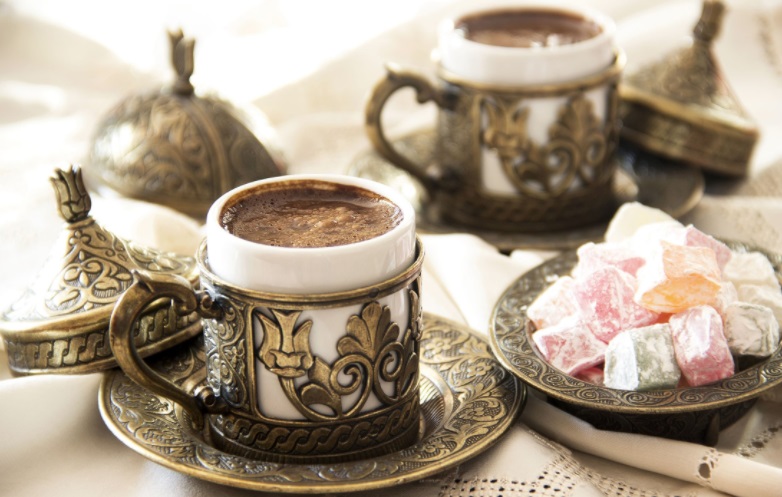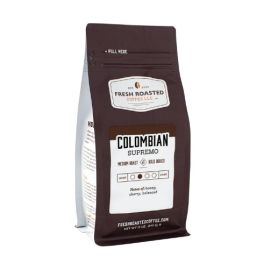
Turkish coffee and Turkish delight hold a revered place in Turkish culture, celebrated not just for their unique flavors but also for their rich historical roots. Turkish coffee, known for its strong aroma and thick, frothy texture, is brewed using a method that dates back to the 16th century Ottoman Empire. It’s more than just a beverage; it’s a cultural ritual that symbolizes hospitality and friendship.
Turkish delight, or ‘lokum’, complements this aromatic coffee with its soft, chewy texture and sweet flavor. This confectionery dates back to the Ottoman times and has been a delicacy in Turkish households and royal courts, often enjoyed during gatherings and special occasions.
Key Takeaways
- Importance of Grind: The grind of the coffee is crucial in Turkish coffee preparation. The beans are ground to a very fine powder, finer than for any other preparation method, which allows its unique flavor and thick consistency.
- Traditional Brewing and Serving: Traditionally, Turkish coffee is brewed in a pot known as a ‘cezve’ or ‘ibrik’. Water, finely ground coffee, and sugar (optional) are added and slowly heated. The coffee is served in small cups, where it is allowed to settle, and is often accompanied by a glass of water to cleanse the palate before sipping.
- Cultural Rituals: Drinking Turkish coffee is a social ritual. It is often consumed in cafes and homes during lengthy conversations. An interesting cultural aspect involves the bride-to-be preparing coffee for her potential groom’s family as a testament to her skills.
- Health Benefits and Cultural Significance of Turkish Delight: Turkish delight is not only delicious but also carries some health benefits, being rich in antioxidants. It is vegan, gluten-free, and can be made in a variety of flavors, including rosewater, lemon, and pomegranate. The treat is deeply ingrained in Turkish tradition and often served during cultural celebrations and with coffee.
Types of Turkish Coffee
Turkish coffee is celebrated not just for its unique preparation method, but also for the variety it offers. Here’s a look at three popular types of Turkish coffee: Menengic, Dibek, and Mirra.
- Menengic Coffee: Often surprising to newcomers, Menengic coffee isn’t made from traditional coffee beans. Instead, it’s derived from the fruits of the Pistacia terebinthus tree, commonly found in Turkey. This type does not contain caffeine, offering a fruity flavor that’s quite distinct from regular coffee. Menengic is especially popular in certain regions of Turkey and offers a smoother, less bitter taste.
- Dibek Coffee: Named after the traditional stone mill used to grind its beans, Dibek coffee features a creamier and lighter texture. The coffee beans are ground to a specific coarseness using a stone pestle and mortar, which is believed to enhance the coffee’s natural flavors. Unlike standard Turkish coffee, Dibek often starts with preheated water, creating a less intense bitterness and a more approachable flavor profile for those new to Turkish coffee.
- Mirra Coffee: Mirra is renowned for its robustness and is typically served extremely strong and bitter. It is a double-roasted coffee, coarser ground than other varieties, and often mixed with cardamom to balance its intense flavors. Mirra is a staple in the southeast regions of Turkey and is an acquired taste, prized for its bold, invigorating essence.
How To Make Turkish Coffee
Making Turkish coffee is an art form, requiring attention to detail and a little patience. Here’s a step-by-step guide on how to brew Turkish coffee using a cezve or ibrik, ensuring you get that much-coveted foam and rich flavor every time.
Ingredients and Tools:
- Finely ground coffee (preferably Turkish grind)
- Water
- Sugar (optional)
- Cezve or ibrik (Turkish coffee pot)
- Small spoon
Step-by-Step Brewing Process:
- Measure Your Ingredients: Start with cold water. For each cup, use about 100 ml of water and two heaping teaspoons of coffee. If you like your coffee sweet, add sugar at this stage.
- Mix in the Cezve: Pour the water into your cezve, add sugar if using, and then add the coffee grounds. Do not stir yet; let the coffee float on the surface as the water heats.
- Heat Gently: Place the cezve on low heat. This is crucial as high heat can burn the coffee. The key is to heat the coffee slowly to allow flavors to develop without boiling the mixture.
- First Stir: Once the coffee begins to sink and the water is warm, give it a gentle stir to help the sugar dissolve and distribute the coffee evenly.
- Watch for Foam: As the mixture heats further, a dark foam will begin to form. This is the critical moment. You want to keep the heat at a level where the coffee does not boil, but hot enough to encourage foam formation.
- Managing the Foam: When you see a ring of bubbles around the edge, reduce the heat. You can spoon some of the foam into your cup at this stage to ensure you get that frothy top.
- Final Heating: Allow the coffee to come just to the brink of boiling, where the foam rises up but before it spills over. Remove from heat immediately.
- Serve Immediately: Pour the coffee into small cups, allowing the grounds to settle at the bottom of the cup. Do not stir once poured.
Tips for Perfect Turkish Coffee:
- Grind Size Matters: The coffee must be ground to a very fine powder, finer than espresso. This is essential for the right texture and to create sufficient foam.
- Water Temperature: Never let the coffee boil. High temperatures can destroy the delicate flavors and burn the coffee, leaving a bitter taste.
- Achieving the Perfect Foam: The foam can make or break a Turkish coffee. It’s all about heat management. Gentle heat helps to form a thick, creamy foam that Turkish coffee is famous for.
How To Serve Turkish Coffee and Turkish Delight
Serving Turkish coffee is an art that enhances the overall drinking experience. Here’s how you can serve it just right, along with Turkish delight, to capture the essence of this beloved tradition.
Preparing the Serving:
- Water First: Always serve Turkish coffee with a glass of water. The water is meant to cleanse the palate before tasting the coffee, ensuring you can fully appreciate its rich flavor.
- Coffee: Pour the coffee into small, pre-warmed cups. The coffee should be allowed to settle for a minute before serving to ensure the grounds stay at the bottom of the cup.
- Turkish Delight: Accompany the coffee with a few pieces of Turkish delight on a small plate. Choose flavors that complement the coffee, such as rose, lemon, or mint.
Enhancing the Experience:
- Setting: Serve Turkish coffee in a serene setting to enhance the sensory experience. Soft background music and minimal distractions can elevate the moment.
- Company: Turkish coffee is best enjoyed in good company. The communal aspect of sharing coffee can turn a simple drink into a meaningful social event.
Cultural Significance and Rituals
Turkish coffee is much more than just a beverage; it’s a crucial part of social and cultural rituals in Turkey. Here’s how it plays a role in various settings:
- Social Gatherings: Turkish coffee is a staple in social settings, often serving as a centerpiece for conversations and gatherings. It’s a way to welcome guests and show hospitality.
- Engagement Traditions: In engagement ceremonies, Turkish coffee plays a unique role. The bride-to-be may prepare coffee for the groom’s family, which serves as a test of her skills. Sometimes, she might even add salt to the coffee instead of sugar to test the groom’s character, observing his reaction as a measure of his temperament.
Health and Nutritional Aspects of Turkish Coffee
Turkish coffee, when consumed black and without added sugars, is low in calories and contains no fats or cholesterol, making it a healthy choice for many. A standard serving contains minimal calories and offers a small amount of vitamins and minerals such as potassium, which helps regulate heart function and fluid balance.
However, adding sugar can significantly alter its nutritional profile, increasing calories and potentially impacting blood sugar levels. Moderation is key when adding sweeteners to maintain the health benefits.
The Link Between Coffee and Turkish Delights
Historically, both Turkish coffee and Turkish delights have their roots in the Ottoman Empire, making them staples in Middle Eastern culinary traditions. The rich, intense flavor of Turkish coffee pairs wonderfully with the sweet, chewy texture of Turkish delights.
This pairing balances the bitterness of the coffee with the sweetness of the confection, enhancing the overall tasting experience and showcasing a blend of flavors that has been celebrated for centuries.
FAQs
Why is my Turkish coffee bitter or not foaming? The bitterness can often result from over-extraction during brewing, typically if the water is too hot or the coffee boils. For the perfect foam, ensure the heat is low and remove the cezve from heat just as the coffee begins to froth, before it starts boiling.
How to prevent coffee grounds from getting into your mouth? Let the coffee settle after pouring it into the cup. You can also add a small amount of cold water to the pot after brewing, which helps the grounds settle more quickly.
Final Thoughts
Turkish coffee isn’t just a beverage; it’s a cultural experience. From its unique preparation and serving methods to the rituals that surround its consumption, Turkish coffee invites you to savor each sip slowly. This rich tradition is a wonderful way to connect with others or enjoy a moment of solitude.









